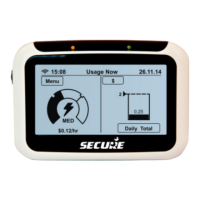6.7.2 Advanced settings
In addition to standard settings, several advanced settings can be configured from a screen accessed by
tapping the Advance button in the top right-hand corner of the Settings screen:
● Electricity consumption (import) tariff
● Electricity generation (export) tariff
● Electricity generation capacity
● CO
2
factor
● Erase data
● Manual disconnection or reconnection of Pipit with Smart
Meter
The advanced settings configurations are protected with a PIN code. The existing configuration can be viewed
without using the PIN, but changing them requires the correct PIN code to be entered. This protection is
provided to prevent accidental changes to certain critical settings that can cause loss of data or
decommissioning of the unit from the network. The following table describes the advanced settings:
Tariff:
Toggles between two types of indicative tariff rate for electricity consumption: ‘Flat’
and ‘Flexible’. The flexible tariff supports up to four tiers.
Gen. Tariff:
For configuring the indicative tariff rate for electricity generation (export).
Gen. Capacity:
For setting the daily generation capacity. In the Home screen the instantaneous data
is calculated as per the defined capacity.
CO
2
Factor:
For setting the CO
2
avoidance factor. The factory default setting is 1.36 kg for each
kWh produced from a carbon source.
Erase Data:
Erases all the historical data stored in the Pipit. This should be used with caution as
it will not be possible to retrieve erased data.
Network:
For manually disconnecting or reconnecting the Pipit with the Smart Meter. If
disconnected manually, the Pipit will automatically attempt to reconnect to the Smart
Meter.
Table 6
6.7.2.1 Configuring tariff rates for consumption
Pipit supports indicative Flat and Flexible tariffs that compute cost based on consumption values collected from
the Smart Meter. The Flexible tariff can be set up with up to four time-of-use slabs, with weekdays and
weekends treated separately. If Flat tariff is configured, the consumption cost for any missing period is derived
by applying the flat rate to the interval data. If a Flexible tariff is configured, the consumption cost for any
missing period is derived from the current applicable price for that period.

